Microsoft previewed its new search platform, MSN Virtual Earth, at the D Conference ("All things digital") in Carlsbad, California, this week.Most commentators immediately linked the announcement to word from Google last week about an update to Keyhole called Google Earth.It's hard to make a comparison with Google Earth since it's still just a "virtual" virtual world.Virtual Earth is a "real" virtual world, in the sense that Mark Law of the MapPoint Business Unit showed us live code.(Release is expected this summer.) He noted during a demonstration earlier this week that should a programmer tweak something, we might see an error.(We didn't).
Beginnings
Virtual Earth has been spinning in Internet time, according to Law.The project was literally suggested to Microsoft CEO Bill Gates in a paper by members the MapPoint Business Unit.It was submitted, with many others, to Bill Gates for his annual "Think Week" reading.And, apparently, it came out a winner.The MapPoint Business Unit, with a new member, the TerraServer team, began work on the project in January.
The idea, explained Law, is to reveal the "real earth in a virtual way," a way that was online, searchable and discoverable.He likened it to another "channel" on MSN akin to Entertainment, Money and others.As one geography professor would put it, "Microsoft wants to offer a way to look at the world through geographic eye glasses (as opposed to Entertainment or Money ones.)"
Navigation and Interface
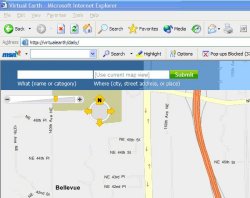 |
MapPoint maps, which are the core data, have a new look and feel.Panning now operates like Google maps: click and drag and the map moves in real time.Users can scroll the mouse wheel to zoom in and out or use a compass-like "game control" to navigate.As Law put it, "We tapped into things we know how to do here at Microsoft." Indeed.
Searching
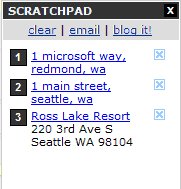 |
Want to do another search on top of the hotel search? Its results overlay the hotels, in a different color.That's very elegant and useful.But it gets better! Pan the map and the searches automatically update in real time for the new geography! That, Law noted, is unique, though we're sure it will not be for long.
Basic routing (with a very "Google-like" interface) will be available in the first release and more advance options, to be introduced later, may include the ability to rearrange stops.
Data
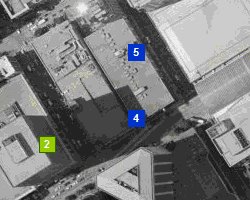 |
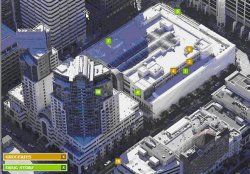 |
Some people, of course, have trouble making sense of orthoimages, so Microsoft has signed a five year deal with Pictometry to provide oblique images, as well as its 6" orthoimages.The oblique layer is still in development (Microsoft is apparently mosaicking the images in some clever way) so we saw just a still image as an example.In time though, images from four different angles will be available, and the user will be able to "look around" a building or block.Microsoft noted that Pictometry already had captured 132 U.S.counties which cover 10 major urban areas.Others are under development.Law promised that in time the street maps would even snap to the oblique imagery, though that won't be in the first release.
Other data layers are expected after the initial release, including weather and traffic "and ones you've not even thought of," said Law.Also on the horizon: the ability to add your own data layers.In the earlier releases there will be just the ability to annotate locations, however.That perhaps led to Law's comment about Virtual Earth being a "social networking tool based on location."
APIs
It appears as though in the early days, users will be able to share Virtual Earth URLs, much like they do MapPoint URLs.Whether the whole interface will be made available as a service is unclear.According to a statement released by Microsoft:
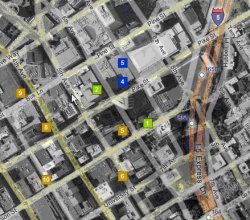 |
"The first version of the Virtual Earth Project will include a URL parameter API for creating rich links into the Virtual Earth, including support for location-based searches, location lookups, map style selection (including the new labeled aerial imagery) and much more.Future releases of the Virtual Earth will include additional developer support and APIs for integrating Virtual Earth functionality directly in third party Web applications."
Development and Release Plan
Virtual Earth will debut this summer.Forty-five day later, the first update is expected.Ninety days later, a full new release is expected.Law made it clear the team did not want to wait for 200 enhancements to provide an update, but would put one out even if only two or three were available.
On the Business Side
In this "war of the worlds" between Microsoft and Google, it is the partners, the "little guys," that are supplying the incremental value to the online mapping search portals.In the case of Google, the acquisition of Keyhole was central to the geographic search and display of remotely sensed imagery.In the case of MSN Virtual Earth, Pictometry is providing the unique perspective by allowing access to its library of oblique (and high resolution ortho) aerial imagery.The announcement Monday by Microsoft and Pictometry signals one of these incremental value plays that Microsoft is offering to lure online viewers in hopes of catching Google in the "geosearch" wars.The big prize is advertising revenue.This move might be considered another attempt by Microsoft to dominate the Internet search landscape the way it has won the battles for operating systems and desktop productivity software.
Pictometry's tag line is "See Anywhere, Measure Anything, Plan Everything." Microsoft is getting the "See Anywhere" part.The "measure" or "plan" capabilities remain the purview of Pictometry's proprietary product offerings and will only be available for purchase either through Pictometry directly at its Pictometry Online website, and likely in the future directly through MSN Virtual Earth.But Microsoft is adding its own twist as well by mosaicking the oblique imagery into a seamless view.Therefore the competitive advantage over Google/Keyhole at this time is a 2.5D view of the landscape.Where Google's imagery looks "flattened" as the viewing angle comes off nadir, the Pictometry view will show the building faces such that you can read the names of the establishments.And now you can see the tie in with advertising.Want to find the nearest Starbucks sequestered among the skyscrapers? No problem.
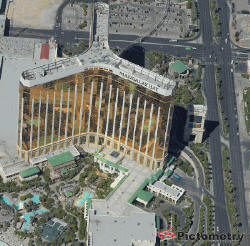 |
"This is hugely profitable for Pictometry," said Dan Pennacchia, Chief Marketing Officer of Pictometry, referring to the deal with Microsoft.Pictometry, with Microsoft touting its name across the Web, now has the potential to reach beyond its current focus on the local government marketplace to extend to business to business (B2B) opportunities in real estate, insurance and banking.Pictometry already has a relationship with CB Richard Ellis (a commercial real estate developer, a division of Caldwell Banker) and many media firms which look to the company for its ability to provide a perspective view of metro areas.
Microsoft has locked in an advantage with Pictometry's library of imagery.The MSN Virtual Earth deal is an exclusive arrangement with the company.Pictometry can provide its data to no other mapping portal for five years.All 132 counties in the United States that Pictometry has flown, representing approximately 25% of the population, will be available to the MSN Virtual Earth portal, but only about 15 will be available at the time the portal launches.Larger metro areas such as Los Angeles, New York, Boston, Atlanta, etc.are planned for inclusion in the first release.If there is overlap in cities where Pictometry has already supplied imagery to a city's Web portal (there are but two such situations in the U.S.), Pictometry is working out solutions.
The agreement with Microsoft was a relatively recent adventure for Pictometry.The company hooked up with Microsoft through a mutual colleague in the TerraServer group.Microsoft was looking for other ways to enhance the MapPoint portal.At the same time, Bill Gate's "Think Week" was approaching and the MapPoint group was looking for ways to get Gate's attention.Pictometry executives held a meeting with Microsoft not more than six months ago and that led to this week's announcement.
What's the Fuss?
The big question here is "why?" Why imagery? Why oblique imagery? Why seamless aerial views? Why are the search wars all of a sudden looking to mapping technology? Believe it or not, the answer is simply money.In the search wars, Pennacchia noted that one or two marketshare points means millions of dollars in advertising.When you can not only put a dot on the map to show where the Starbucks is, but also show a picture of the sign in front of the store to let you know you have the right building, that's a unique competitive advantage.
And that's just if you were searching online.What about the location-based service from a Sprint, Nextel, Cingular or Verizon Wireless phone? You're walking down the street and your GPS-equipped cell phone shows you an image of the store.That's a unique competitive advantage.And what if you are driving on unfamiliar streets looking to establish a little cache with the new office crew by bringing them some Krispy Kremes? Up pops the image map on your in-vehicle Internet portal.Donuts found! That's a unique competitive advantage.
Microsoft described the opportunity with Pictometry this way: "MSN Virtual Earth sets forth a new search frontier that extends traditional local searching into a deeply immersive search experience, where consumers see what it's like to be in a location and explore what they can do there.The unique aerial imagery from Pictometry enables Microsoft to deliver a one-of-a-kind immersive local search experience for our customers."
In short, it's all about branding, both from Microsoft's and Pictometry's perspective.Microsoft establishes "a unique competitive advantage;" Pictometry becomes known to a completely new audience to offer its products and services in both the B2B and business to consumer markets.Watch this space.